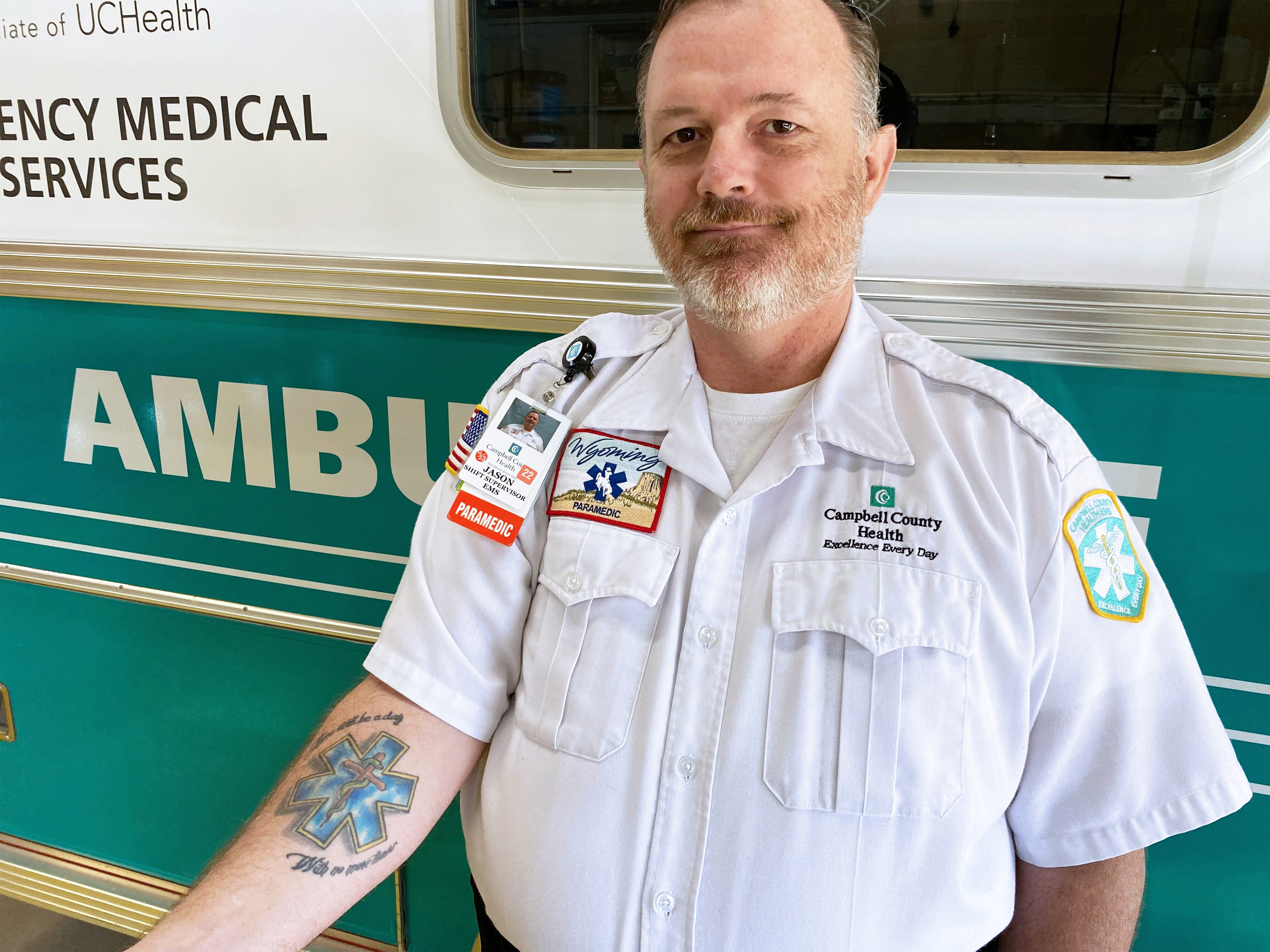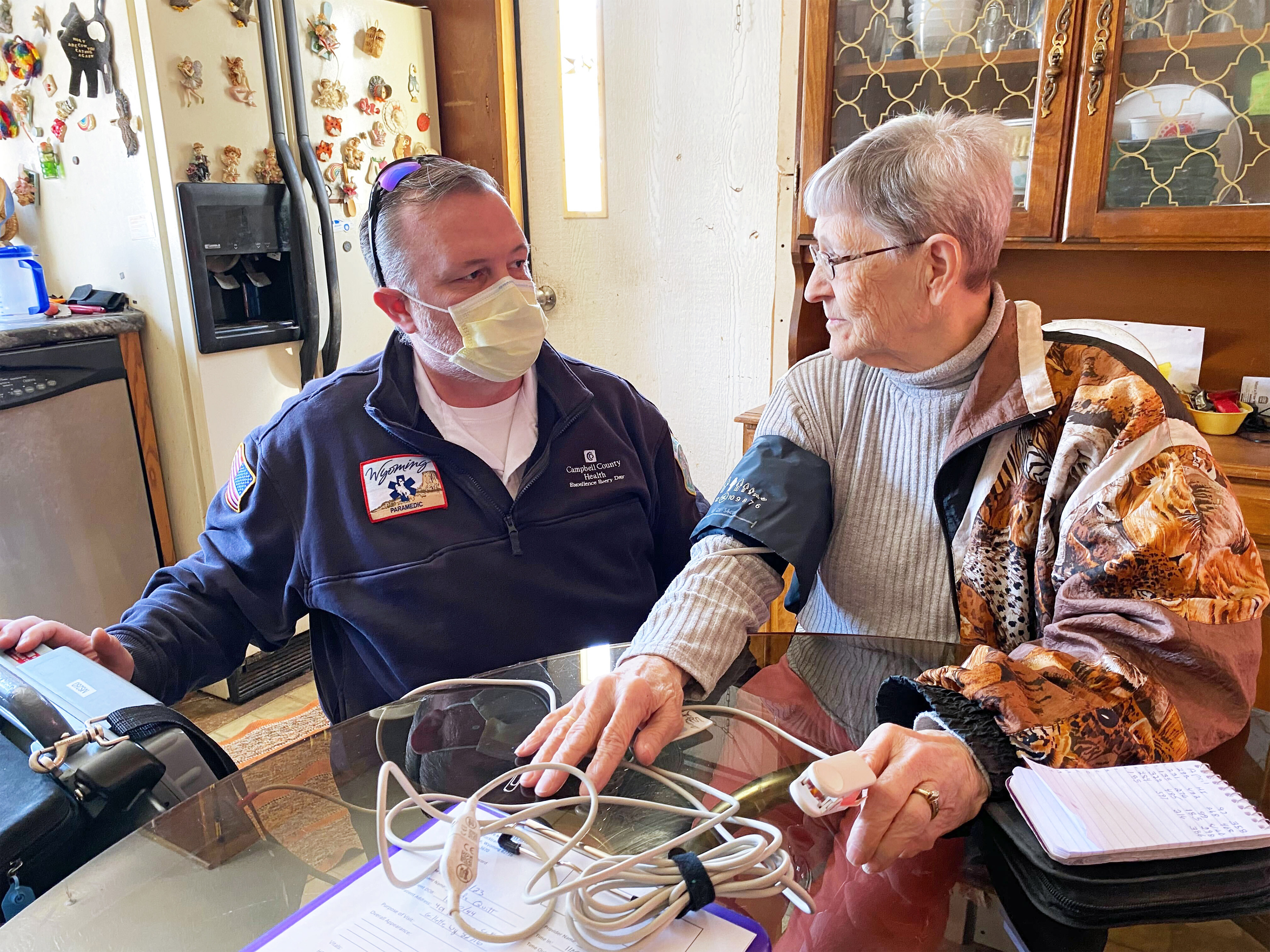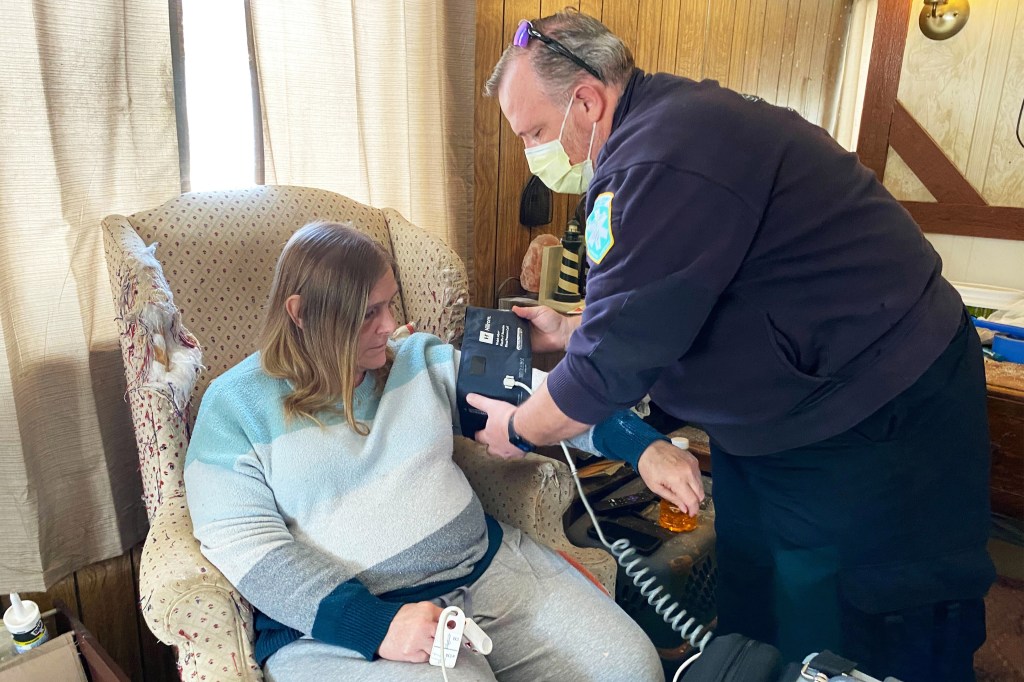GILLETTE, Wyo. — Sandra Lane said she has been to the emergency room about eight times this year. The 62-year-old has had multiple falls, struggled with balance and tremors, and experienced severe swelling in her legs.
A paramedic recently arrived at her doorstep again, but this time it wasn’t for an emergency. Jason Frye was there for a home visit as part of a new community paramedicine program.
Frye showed up in an SUV, not an ambulance. He carried a large black medical bag into Lane’s mobile home, which is on the eastern edge of the city, across from open fields and train tracks that snake between the region’s massive open-pit coal mines. Lane sat in an armchair as Frye took her blood pressure, measured her pulse, and hooked her up to a heart-monitoring machine.
“What matters to you in terms of health, goals?” Frye said.
Lane said she wants to become healthy enough to work, garden, and ride her motorcycle again.
Frye, a 44-year-old Navy veteran and former oil field worker, promised to help Lane sign up for physical therapy and offered to find an anti-slip grab bar for her shower.
Community paramedicine allows paramedics to use their skills outside of emergency settings. The goal is to help patients access care, maintain or improve their health, and reduce their dependence on costly ambulance rides and ER visits.
Such programs are expanding across the country, including in rural areas, as health care providers, insurers, and state governments recognize the potential benefits to patients, ambulance services, and hospitals.
Gary Wingrove, a Florida-based leader in community paramedicine, said the concept took off in the early 2000s and now includes hundreds of sites. A 2017 survey of 129 programs found that 55% operated in “rural” or “super rural” areas.
Community medicine can be helpful in rural areas where people have less access to health care, said Wingrove, chair of the International Roundtable on Community Paramedicine. “If we can get a community paramedic to their house,” he said, “then we can keep them connected to primary health care and all of the other services that they need.”

Frye works at Campbell County Health, a health care system based in Gillette, a city of about 33,000 in northeastern Wyoming. Leaders of the community paramedicine program plan to expand it into two adjacent, largely rural counties dotted with ranches and coal mines on the rolling prairie that stretches more than 100 miles from the Black Hills to the Bighorn Mountains.
Gillette serves as a medical hub for the region but has shortages of primary care doctors, specialists, and mental health services, according to a community needs assessment. People who live outside the city face additional barriers.
“A lot of them, especially older people, don’t want to come into town. And basically, those tiny communities don’t usually have health care,” Lane said. “I think it’s just kind of a pain for them to drive all the way into town, and unless they have a serious problem, I think they tend to just figure, ‘Well, it’ll work itself out.’”
Community paramedicine programs are customized to the needs and resources of each community.
“It’s not just a cookie-cutter-type operation. It’s like you can really mold it to wherever you need to mold it to,” Frye said.
Most community paramedicine programs rely on paramedics, but some also use emergency medicine technicians, nurses, social workers, and other professionals, according to the 2017 survey. Programs can offer home visits, phone check-ins, or transportation to nonemergency destinations, such as urgent care clinics and mental health centers.
Many programs support people with chronic illnesses, patients recovering from surgeries or hospital stays, or frequent users of 911 and the ER. Other programs focus on public health, behavioral health, hospice care, or post-overdose response.
Community paramedics can provide in-home vaccinations, wound care, ultrasounds, and blood tests.
They can offer exercise and nutrition tips, teach patients how to monitor their symptoms, and help with housing, economic, and social needs that can affect people’s health. For example, paramedics might inspect homes for safety hazards, provide a list of food banks, or connect lonely patients with a senior center.
Paramedics and patients said some rural residents struggle to access health care because of long distances, cost, lack of transportation, or dangerous weather. Some hesitate to seek help out of pride or because they don’t want to be a burden to others. Some limit trips to town during ranching and farming crunch times, such as calving and harvesting seasons.
Delayed care can let health problems fester until they become an emergency.
Advocates say providing in-home care, resources, and education can help patients reduce such crises and associated costs. Fewer emergencies mean fewer ambulance runs and hospital patients. That could help ambulance services and hospitals reduce costs and the time patients wait for help.
A 2022 scholarly review found that more studies are needed but that data so far suggests these programs reduce costs. It also found links to improved health outcomes and decreased use of ambulances and hospitals.
For example, a pilot program in Fort Worth, Texas, saw a 61% reduction in ambulance rides, according to an academic study of 64 patients. MedStar, the operator, made the effort permanent and says its 904 participants needed 48% fewer ambulance trips, saving an estimated $8.5 million over eight years.
But rural ambulance services, especially volunteer ones, can struggle to staff and fund community paramedicine programs.
Kesa Copps, a co-worker of Frye’s, previously worked as an emergency medical technician in Powder River County, Montana, which has fewer than 2,000 residents. Some people there must drive more than an hour to reach the nearest hospital. The area’s volunteer ambulance service started a community paramedicine program in 2019.
Copps said the program reduced hospital readmissions and extended some elderly patients’ ability to live at home before being admitted to a nursing facility. She visited patients between ambulance runs and had to leave early when a 911 call came in. That’s different from the Campbell County Health model, in which community paramedicine is a full-time position, not split with emergency work.
Adam Johnson, director of the Powder River ambulance service, said the community paramedicine program shut down in 2021 after everyone with the necessary training left the area. Johnson said paramedics are signing up for training to restart the program.
States are increasingly recognizing and regulating community paramedicine, and some require licensed paramedics to obtain extra training to work in the field.
Some ambulance services and health care organizations have piloted community paramedicine programs with the help of state or federal grants. If they find the service saves money, they may decide to continue the program and fund it themselves.
Private insurance companies are increasingly covering community paramedicine, Wingrove said. Wyoming and several other states allow operators to bill Medicaid for the services.
Advocates are now pushing Medicare to expand its limited coverage of community paramedicine, Wingrove said. That would benefit Medicare patients and could spur more private insurers to offer coverage.
The Campbell County Health program’s home visits cost up to $240 per hour and are billed to Medicaid or Medicare, said Frye. That compares with more than $1,300 for an ambulance ride and thousands of dollars for a visit to a hospital ER.
Community paramedicine may soon expand in neighboring South Dakota, another largely rural state.
South Dakota ambulance services have experimented with community paramedicine and lawmakers recently voted to authorize and regulate it.
Eric Emery, the state representative who introduced the bill, plans to start a program on the sprawling, rural Rosebud Indian Reservation, where he works as a paramedic. He said the operation will focus on diabetes and mental health care.
Emery, a Democrat, said some people struggle to pick up their medication and attend appointments because they lack vehicles or gas money and there’s no public transportation to the hospital. He said some parents and grandparents raising children also struggle to find time to drive to appointments.
“They’re putting the needs of the younger generation or their grandkids before their own,” Emery said.

Back in Gillette, Frye also checked in on Linda Quitt, a 78-year-old facing diabetes, depression, and a lack of social support after her husband was hospitalized with dementia. Quitt said her husband was her walking buddy and helped care for her.
“I had him to wait on me, and now I have nobody,” Quitt said.
Frye said he would see if he could help start a senior walking group that Quitt could join. He told her that socializing can improve health.
“You’re not alone,” Frye told Quitt.
This article was produced by KFF Health News, a national newsroom that produces in-depth journalism about health issues and is one of the core operating programs at KFF — the independent source for health policy research, polling, and journalism.
[Correction: This article was updated at 1:40 p.m. PT on May 11, 2023, to correct the spelling of Linda Quitt’s surname.]



